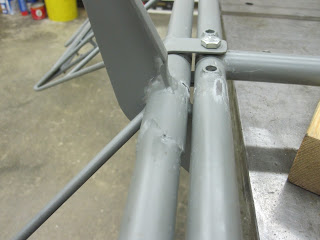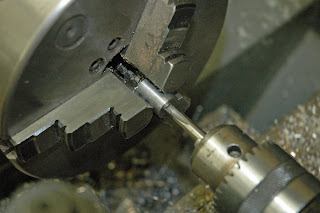
The new engine mount for the Continental O-200 is fitted and tacked ready for final welding. Based on Hawkeye's aft C.G. condition and comparison to the weight and geometry of the Jab 3300, I decided to move the O-200 forward by 2" from the position specified in the plans. The plans call for 10" between the firewall and the back of the engine mount but this mount is 12".

At the risk of over doing a simple subject, I have put together a full sequence of fitting a tube to two parallel intersecting tubes using the "tube miter" software to print patterns. www.ozhpv.org.au/shed/tubemiter.htm

We are mating a 3/4" tube with a 1/2" tube. The tube miter program assumes that the 1/2" tube will pierce the 3/4" tube. This means that about 1/2 of the printed pattern will need to be discarded. Note that the tube miter program works in mm dimensions.

This is the part we need.


I use 3/8" flat stock to find the center line of the 3/4" tubes. Clamp the tube to the bench and mark each end on opposite sides. This will be used to align the patterns on each end.


Determine the length of the tube. This requires a little estimating using a tape measure and "eyeballing" the portion where the tape won't fit in. Align the pattern with the center lines on the tube and tape it in place.

Rough cut the tube on the band saw.


Grind the tube to match the pattern and check the fit. Because we are fitting a 3/4" tube to a 1/2" tube, the shaped end of the larger tube will need to be squeezed down for a better fit to the smaller tube.

I was very pleased that I managed to cut and fit all of the tubes for this mount without scrapping a single tube!
 Here goes nothing!
Here goes nothing! Bottom side covered. You can see the anti-chafe tapes on the ribs.
Bottom side covered. You can see the anti-chafe tapes on the ribs. Finished with the basic wrap.
Finished with the basic wrap. Repeat the process for the vertical stab.
Repeat the process for the vertical stab.
 I plan to cover the rudder and elevator before I rib-stitch and apply the finish tapes.
I plan to cover the rudder and elevator before I rib-stitch and apply the finish tapes.












































